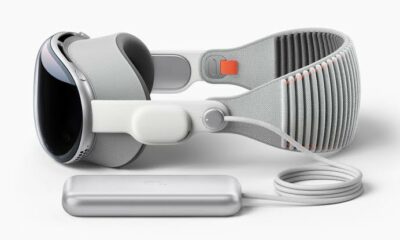Tech News
TOP 5 TECHNOLOGIES THAT HAVE CHANGED SPORT
Sports today use increasingly complex technologies to enhance performance.
We have seen some considerable leaps forward in sporting performance as a direct result of technology either used during competition or in training, but the big question is which technology has had the biggest impact on its respective sport?
Below, we have listed the top 5 technologies that have had a profound effect on sports.
Video Technology
Several sports have adopted in-game video analysis and video refereeing.
This includes rugby, the NFL, tennis and even soccer (to a lesser extent). It has meant that decisions can be made quickly and accurately, allowing correct decisions to be made in more instances as these games become increasingly fair.
Many believe that this has taken some of the fun out of sport, but the truth is that it simply makes it fairer and creates a situation where players know that should they break a rule, they are far more likely to be caught.
Having several cameras around a pitch has also had a major effect on the way that players are analyzed after competition across almost every sport. The ability to look at a performance on a screen and make judgements on it has allowed coaches and analysts to look at individual elements of a performance and make decisions based on what they can see. This is then filtered into the training regimes of the athlete, allowing for better performances and better chances of success.
Portable Sensors
Cycling used to be very much a sport of feel and arbitrary judgement, riding a certain distance or climbing up a particular hill so many times was enough to prepare people for a race. Along came heart rate monitors and people could train within particular heart rate zones, but this was still only analyzing what the effort was doing to the body, rather than what the effort was doing for the actual performance.
When power meters came along, it allowed cyclists to train in accordance with how much power they were pushing through the pedals. Having the ability to train at a consistent level with the readings appearing on a screen in the handlebars meant that consistent power could be achieved, something that is vital in the modern day peloton. Team Sky may not have been the first team to use power meters, but the way they utilized them changed the way that every professional team trains and has totally changed the landscape of cycling from a sport based on feelings to arguably the most number intensive sport in the world.
Similarly, we can see the use of GPS sensors that have allowed rugby, football and soccer coaches to see exactly where a player is at any point during a match, then look at their movements and see how these can be changed to improve the athlete.
These kinds of sensors are also constantly evolving and getting smaller, making even more impact on performance whilst being able to pick up the most minute information. It has been predicted that soon they will be embeddable within everyday clothing, allowing for complex measurements to be taken constantly and improving analysis even further.
Drug Testing & WADA
Not strictly an individual technology, but more a collection of technologies that has changed almost every sport in the world.
Until 1999 there had been small scale and uncoordinated drug tests across individual sports, but these were fairly easily bypassed and in many sports drug abuse to improve performance was endemic.
Since then, WADA (World Anti Doping Agency) has helped to push forward the use of drug testing technologies to help fight the use of performance enhancing drugs in sport. This has levelled the playing field in many sports and helped to weed out some of the biggest drugs cheats in world sport, from Lance Armstrong to Dwayne Chambers.
It has given faith in performances back to the athletes too. Before when an outstanding individual performance occurred it was treated with a degree of suspicion, today thanks to this technology, people may have doubts, but athletes can point to reliable drugs testing to show that it is a clean result.
Aero and Hydrodynamics
When elite athletes in sports that require speed and stamina perform in competition, they need to be able to do so with minimum resistance and this has been recognized across several sports today. From the materials used in swimming costumes through to the curves on a Formula 1 car, the understanding of aero and hydrodamics has allowed the performance of athletes to minimize air resistance and increase speed.
The use of aerodynamics as a decider between winning and losing was shown emphatically in the 1989 Tour de France final time trial where Greg LeMond sat in second place 50 seconds behind Laurent Fignon. He adopted aerodynamic handlebars and helmet whilst Fignon did not. LeMond eventually beat Fignon by 58 seconds, winning the three week event by only 8 seconds. Later analysis through wind tunnel data showed that the use of the bars alone gained LeMond 1 minute and the helmet 16 seconds. Essentially if Fignon had adopted this new technology, he would have won the event.
Data Analytics
Having the ability to analyze millions of data points has meant that sports teams and athletes can look at the tiniest successes or failures within any performance and either recreate or remove particular conditions.
It has meant that everything that an athlete does can be interconnected and assessed to divide a performance into its individual elements, rather than as a simple whole. It has been the basis of the current obsession with marginal gains that coaches are interested in. The idea behind this being that if they can find a 0.1% improvement in any part of a performance, then this will give them a slight advantage, but if they can find this number in several areas then they can add up to a significant improvement. It was this philosophy that led the British Olympic team to much success during the past 3 Olympics.
This philosophy is only made possible through the use of data analytics as it allows for the tiniest details of an athletic performance to be studied, seeing where small improvements can be made and how athletes can improve their chances of success.
Source: https://channels.theinnovationenterprise.com/articles/top-5-technologies-that-have-changed-sport
You may like
-


Apple fans are starting to return their Vision Pros / Comfort, headache, and eye strain are among the top reasons people say they’re returning their Vision Pro headsets.
-
Google’s AI Chatbot Gemini Raises Privacy Concerns with Data Retention Strategy
-


OpenAI CEO wants to raise not billions, but trillions, here’s why

